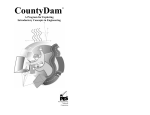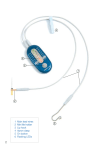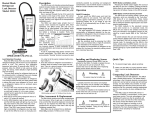Download Dam-It Dams, Inc
Transcript
Providing Water Solutions Worldwide Since 1928 User Manual www.damitdams.com (313) 886-6761 546 E. Reid Rd. Grand Blanc, Michigan 48439 © 2015 All Rights Reserved Dam-It Dams, Inc. User Manual Introduction Purpose This Manual provides important information about Dam-It Dams’ Award-Winning portable, water-filled Cofferdams and Cofferdam Systems. has been prepared to help new, current and future users of Dam-It Dams’ Cofferdams and Cofferdam Systems. Although not designed to be a comprehensive guide, the following topics are addressed in significant detail to give you important information about our cofferdams, including installation, maintenance and removal: Applications Installation Example Specifications Installation Guidelines Small Cofferdam Installations Large Cofferdam Installations Cofferdam Connections Maintenance and Repairs Removal If this Manual does not provide the information you need or if you have any questions, please do not hesitate to contact us. Company Background and Information Dam-It Dams, Inc. has been an innovator in cofferdams and cofferdam systems since 2000. We are dedicated to providing the best product and the best service in the industry. Our patented, portable cofferdams use on-site water to manage, move, dam or divert water with minimal or no impact on the environment. In addition, we offer a wide selection of various types of cofferdams that provide cost effective and highly adaptable solutions for virtually every contractor’s need. We are headquartered in Fenton, Michigan, about 45 miles northwest of downtown Detroit. We can be ready within a moment’s notice to travel anywhere in the world to bring portable water solutions where they are needed…from projects we’ve completed in Alaska and Dubai to right in our own backyard. Today, Dam-It Dams is the Midwest’s Largest Manufacturer of portable water-filled cofferdams. They are made of a heavy-duty, geotextile woven polypropylene outer casing. Our dams create an effective water barrier that leaves no or only a minimal July 2013_Draft 2 Table of Contents ii Dam-It Dams, Inc. User Manual footprint on the environment. They work with Mother Nature, not against her. And because of their industrial strength, our cofferdams are reusable. Precautions No two cofferdam projects are exactly the same. Soil and weather conditions alone can affect everything from initial transport to ultimate removal. The descriptions, instructions, photos, procedures and other information contained in this User Manual are provided to help you with the success of your project. However, they are primarily Guidelines that may not provide definitive answers to all the specific issues that may arise. If you need help or have any questions about the installation, maintenance or removal of Dam-It Dams’ cofferdams or cofferdam systems, please contact us at (248) 755-7383 or visit www.damitdams.com. Table of Contents What Is a Cofferdam? ...............................................................................................5 How Does a Cofferdam Work? ...................................................................................7 Applications ............................................................................................................ 10 Installation Example ................................................................................................ 13 Specifications .......................................................................................................... 17 Height, Width and Length ................................................................................... 17 Height and Width Recommendations ................................................................... 17 Water Depth ...................................................................................................... 17 Water Width ...................................................................................................... 18 Length .............................................................................................................. 18 Cofferdam Water Capacity .................................................................................. 20 Installation Guidelines ............................................................................................. 22 Overview ........................................................................................................... 22 Site Analysis and Preparation .............................................................................. 22 Small Cofferdam Installations .................................................................................. 23 Size ................................................................................................................... 23 Equipment Needs ............................................................................................... 23 Project Personnel ............................................................................................... 23 Site Preparation ................................................................................................. 23 July 2013_Draft 2 Table of Contents iii Dam-It Dams, Inc. User Manual Installation Procedures ....................................................................................... 23 Large Cofferdam Installations .................................................................................. 29 Size ................................................................................................................... 29 Equipment Needs ............................................................................................... 29 Project Personnel ............................................................................................... 30 Site Preparation ................................................................................................. 30 Installation Procedures ....................................................................................... 31 Cofferdam Connections ........................................................................................... 37 Connection Procedures ....................................................................................... 37 Maintenance and Repairs......................................................................................... 42 Maintenance Guidelines ...................................................................................... 42 Repair Procedures .............................................................................................. 42 Removal ................................................................................................................. 43 Small Cofferdam Removal ................................................................................... 43 Large Cofferdam Removal .................................................................................. 43 July 2013_Draft 2 Table of Contents iv Dam-It Dams, Inc. User Manual What Is a Cofferdam? A cofferdam is a temporary enclosure in or around a body of water that is constructed to allow dewatering, diversion or damming of an enclosed area. The primary purpose of a cofferdam is to create a dry environment for a project to proceed. They were first used in 1736. Figure 1 – A fully inflated cofferdam holds back water from the work site. Today’s cofferdams are typically conventional embankment dams of both earth- and rock-fill, although concrete or some sheet piling also may be used. Dam-It Dams’ cofferdams use on-site water to fill dual inner tubes that cause the dam’s chambers to slowly and evenly inflate, forming a strong, stable cylindrical tube. As the inner tubes continue to fill and the water pressure builds, the dam unrolls in a controlled manner to create the cofferdam. July 2013_Draft 2 Cofferdam Description 5 Dam-It Dams, Inc. User Manual Figure 2 – Workers unroll a cofferdam in preparation for inflation. July 2013_Draft 2 Cofferdam Description 6 Dam-It Dams, Inc. User Manual How Does a Cofferdam Work? This is a cross section of a standard Dam-It Dams cofferdam: Figure 3 – This is a cross section of a standard Dam-It Dams’ cofferdam. Our cofferdams have three basic parts: Part A – An outer casing that is made of heavy-duty, geotextile woven polypropylene contains two side-by-side inner tubes (Parts B & C). Part B – This inner tube – in combination with Part C – acts as a stabilizer to keep the dam from rolling due to outside water pressure or other forces. Part C – The companion to Part B. Acting together and when filled with on-site water, Parts B and C provide the ideal combination of weight, mass and pressure to stabilize the cofferdam while the project proceeds. When water (onsite or otherwise) is pumped into the dual inner tubes, the outer casing confines the inner tubes to create counter-balanced pressure that stabilizes the cofferdam against external factors, such as lateral water movement. July 2013_Draft 2 Cofferdam Description 7 Dam-It Dams, Inc. User Manual Figure 4 – Dam-It Dams’ cofferdams can withstand tremendous lateral pressure. The materials used in our cofferdams are very durable and flexible. They can be molded to perfectly fit a lake bed, river bed, watershed or any other type of physical setting. Not only does this make for an excellent seal, it also helps ensure minimal onsite water escape. July 2013_Draft 2 Cofferdam Description 8 Dam-It Dams, Inc. User Manual Figure 5 – Cofferdams mold to the environment to seal and prevent water escape. July 2013_Draft 2 Cofferdam Description 9 Dam-It Dams, Inc. User Manual Applications There are hundreds of applications for which Dam-It Dams’ Cofferdams are perfectly suited – too many to fully describe in this Manual. However, the following are some of the most frequently requested: Boat Ramp Dewatering Bridge/Pier Repairs Chemical Spills Control Construction Site Dewatering Dredging Environmental Remediation Environmentally Sensitive Area Protection Fish Habitat Protection Flood Barriers Foot Causeways Hazardous Material Contamination Control Levee Construction and Repairs Pipeline Crossings Pond Liners and Repairs Shoreline Restoration Water Storage Wetland Management In today’s highly regulated-environmental industry, alternatives to earth-filled barriers (for example, sandbags) are required. There currently is no better alternative than a water-filled, portable cofferdam. It is the most adaptable and least costly means of managing water while protecting the environment. July 2013_Draft 2 Applications 10 Dam-It Dams, Inc. User Manual Figure 6 – A cofferdam holding back water so work can proceed. Dam-It Dams has successfully worked with the US Army Corps of Engineers, the Department of Transportation and leading engineering firms throughout the United States and worldwide to solve complex dewatering and water containment challenges. With current weather and climate changes causing unpredictable water movement and an expanded need for flood control, the speed with which our Portable Cofferdams can be installed make them indispensable for emergency situations. Figure 7 – A rolled up cofferdam arrives at the work site. July 2013_Draft 2 Applications 11 Dam-It Dams, Inc. User Manual Figure 8 – Our cofferdams are portable and readily available for any situation, including emergencies. The following sections will continue the description of Dam-It Dams’ Cofferdams and Cofferdam Systems, including specifications, installation, maintenance, repairs and removal. July 2013_Draft 2 Applications 12 Dam-It Dams, Inc. User Manual Installation Example The 8-step process on the following pages shows a simple, uncomplicated installation of a Dam-It Dams cofferdam. Step 1: The rolled-up Dam is delivered to the job site on a truck or trailer. Step 2: The Dam is lifted from the trailer and placed at the shoreline. July 2013_Draft 2 Installation Example 13 Dam-It Dams, Inc. User Manual Step 3: Two identical pumps are hooked up to fill the internal tubes with onsite water. Step 4: As the pumps fill the Dam, the Dam unrolls and is guided into place. July 2013_Draft 2 Installation Example 14 Dam-It Dams, Inc. User Manual Step 5: The Dam is nearly fully inflated as it reaches the opposite shore. Step 6: The water is pumped from the dry side to the wet side of the Dam. July 2013_Draft 2 Installation Example 15 Dam-It Dams, Inc. User Manual Step 7: The work for the project at hand can now get done on the dry side. Step 8: Empty the dam, roll it up, put it on the trailer and move it to the next job. July 2013_Draft 2 Installation Example 16 Dam-It Dams, Inc. User Manual Specifications There are four key measurements you must know to make sure the cofferdam you order is right for your project – height, width, length and depth of the water to be contained/diverted. Height, Width and Length Dam-It Dams’ Cofferdams are available in a wide range of heights and lengths: Inflated heights range from one foot to 12 feet Inflated widths range from two to 23 feet Standard lengths are 50 and 100 feet, although any length cofferdam can be fabricated to meet specific project needs Height and Width Recommendations The height and width of the cofferdam(s) you will need for your project depend on many factors, including water depth to be controlled, bank slope, waterbed slope and water velocity. Water Depth Depth of the water to be contained or diverted is a critical factor in determining correct cofferdam size. Use the following procedure to calculate water depth for your project: Step 1. Measure the maximum water depth at the installation site. Step 2. Calculate the average water depth at the installation site. Step 3. Calculate the difference in water level elevations between the installation site and the containment or diversion site. Step 4. Add these three numbers to find the projected maximum water depth after the cofferdam has been installed. Knowing the projected maximum water depth will ensure your cofferdam is adequately sized for the project. Too often, this measurement is underestimated. The result can be a cofferdam this is too small, causing time delays, increased costs and avoidable unsafe working conditions. July 2013_Draft 2 Specifications 17 Dam-It Dams, Inc. User Manual The following chart provides guidelines for the height and width of a cofferdam from Dam-It Dams: Height (inflated) (feet) Width (inflated) (feet) Maximum Water Depth (inches) 1 2 9 2 4 18 4 10 38 6 17 56 8 19 72 10 23 86 12 27 108 Note about Water Velocity Water velocity must be taken into account when calculating the projected maximum water depth. As a cofferdam fills with water and unrolls, the active water being diverted will begin to back up and rise. Water velocity at the end of the cofferdam increases. The water bed may erode at the end, increasing water depth at the spot. Faster-flowing water will exaggerate this condition. Water Width It only makes sense that a wide, shallow river is easier to dam than a narrow waterway. Wideness allows minimal fluctuations in water depth while narrowness encourages large increases. As a general rule, the wider the water channel, the less water depth will increase. Length The longest cofferdam we have installed to date was 1,000 feet from end-to-end. It was accomplished by joining together individual cofferdams of varying lengths with coupling collar connections. July 2013_Draft 2 Specifications 18 Dam-It Dams, Inc. User Manual Using the same technique allows us to configure a Cofferdam System in a straight line, around corners and/or in a circle. Figure 9 – A long cofferdam with coupling collar connections. Figure 10 – Two cofferdams joined by a coupling collar. July 2013_Draft 2 Specifications 19 Dam-It Dams, Inc. User Manual Figure 11 – Cofferdams can accommodate several different angles to keep water out. Figure 12 – Even in a circle… Cofferdam Water Capacity Finally, it is also important to know the water capacity of the cofferdam you will be using to determine project team size, equipment and the size and number of pumps needed. The internal water capacity of a standard Dam-It Dams Cofferdam is 7.48 gallons per cubic foot. The following chart shows the water capacities of various-sized, fully filled cofferdams: July 2013_Draft 2 Specifications 20 Dam-It Dams, Inc. User Manual Dam-It Dams Cofferdams Water Capacity Height (feet) Width (feet) Length (feet) Total Cubic Feet Water Capacity (gallons) 1 2 50 100 748 100 200 1,496 50 400 2,992 100 800 5,984 50 2,000 14,960 100 4,000 29,920 50 5,100 38,148 100 10,200 76,296 50 7,600 56,848 100 15,200 113,696 50 11,500 86,020 100 23,000 172,040 50 16,200 121,176 2 4 6 8 10 12 4 10 17 19 23 27 100 242,352 Dam-It Dams will gladly assist you in determining the Water Capacity of the specific cofferdam being used for your project. July 2013_Draft 2 Specifications 21 Dam-It Dams, Inc. User Manual Installation Guidelines Overview Dam-It Dams’ cofferdams are typically fabricated at the factory and delivered – rolled and ready-to-use – to the project site. Larger cofferdams may be assembled at the site. When delivered, the cofferdam comes on a solid core that aids installation and transportation and also allows for re-use. Figure 13 – Workers guide the unrolling of a large cofferdam as it inflates. Site Analysis and Preparation In a perfect world, all cofferdams installations would occur on level water beds free of rocks, boulders and debris. In our world, these impediments must be addressed before a cofferdam can be properly installed. Water beds with large boulders, jagged rocks and/or excessive debris must be cleared to ensure a good seal for the cofferdam. These impediments must be removed or relocated by hand or heavy equipment prior to installation. Smaller rocks and debris may be removed or repositioned during installation. Rocks can be repositioned from the upstream side of the cofferdam to the downstream side to provide additional dam support. July 2013_Draft 2 Installation Guidelines 22 Dam-It Dams, Inc. User Manual Small Cofferdam Installations Size For purposes of this manual, a small cofferdam is no more than four feet high. Equipment Needs The following equipment is recommended for small cofferdam installations: Two portable 2”-3” water discharge pumps A discharge/suction hose for each pump (Other Equipment – Jack will provide list) Project Personnel Two to four workers are needed to install a small cofferdam. Individual project constraints (time, site availability, etc.) will dictate if additional workers are needed. Site Preparation Prepare the site my moving or removing boulders, rocks and debris that may interfere with proper installation of the cofferdam. If necessary, level the water bed. Keep excavation to a minimum. Also, do not install cofferdams on freshly removed materials. Installation Procedures The following procedures provide guidelines for installing a Small Cofferdam. Because each project is unique, contact Dam-It Dams if you have any questions about your specific project or need additional information. Step 1. Delivery Transport or have the Dam-It Dams’ cofferdam(s) delivered to the project site. July 2013_Draft 2 Large Cofferdam Installations 23 Dam-It Dams, Inc. User Manual Figure 14 – Rolled up cofferdams arrive on a flatbed at the project site. July 2013_Draft 2 Large Cofferdam Installations 24 Dam-It Dams, Inc. User Manual Step 2. Position the Cofferdam One end of the cofferdam has the long fill tubes. These are used to fill the cofferdam with water and for connecting multiple cofferdams, if necessary. Figure 15 – Fill tubes carry water from the discharge pumps to inflate the cofferdam. The actual cofferdam starts at the edge of the Casing that holds the fill tubes. Position the edge of the Casing on one bank of the project site at least as high as the cofferdam will be when fully inflated. This is called the Starting Point. Taking into account the slope of the bank, make sure the Starting Point is higher than the water level inside the cofferdam after inflation. The cofferdam will be a maximum of three+ feet at the lowest point of installation. (Note: If the bank is not steep enough to attain the needed Starting Point, use fill material to create a false bank.) July 2013_Draft 2 Large Cofferdam Installations 25 Dam-It Dams, Inc. User Manual Figure 16 – A cofferdam is properly positioned at the Starting Point. Step 3. Prepare the Cofferdam for Inflation Place one end of a discharge hose inside each fill tube. Secure the hoses by wrapping the tubes with duct tape. If necessary, tie the end corners of the cofferdam to a stationary object (tree, boulder, etc.) to keep it from sliding down the bank. Step 4. Initiate Cofferdam Inflation Start pumping water into both fill tubes at the same time and at the same rate. Position workers at the rolled end of the cofferdam. As the cofferdam inflates and begins to unroll, the workers should wait for water pressure to build inside the cofferdam. July 2013_Draft 2 Large Cofferdam Installations 26 Dam-It Dams, Inc. User Manual Figure 17 – A worker guides the cofferdam as it inflates and unrolls. When the cofferdam reaches the desired height, the workers should take a step back, wait until the height is restored and take another step backward. Complete this process until the cofferdam is fully inflated. The water level inside the cofferdam must be kept higher than the upstream water side. Remember, upstream water depth will increase as the cofferdam constricts water flow. It is important that the workers step back in unison as the cofferdam unrolls to prevent injury. July 2013_Draft 2 Large Cofferdam Installations 27 Dam-It Dams, Inc. User Manual Figure 18 – Workers work in unison as the cofferdam inflates and unrolls. Step 5. Ensure a Good Seal If you have not already removed boulders, rocks and debris from the project site, now is the time. These impediments oftentimes can only be located by feel. They must be removed before the cofferdam is unrolled or while it is unrolling to ensure a good seal, prevent leakage and avoid damage to the cofferdam. Step 6. Inflate the Cofferdam There are four important things to remember when inflating the cofferdam: Maintain water pressure inside the cofferdam at all times during inflation. A cofferdam that unrolls too quickly may not inflate above the surrounding water level and will move with the water flow. Move impediments to the downstream side of the cofferdam (they also may be used for support). Always inflate the cofferdam with the maximum amount of water to achieve desired height. July 2013_Draft 2 Large Cofferdam Installations 28 Dam-It Dams, Inc. User Manual Figure 19 – A fully inflated cofferdam. Large Cofferdam Installations Size For purposes of this manual, a large cofferdam is more than four feet high. Equipment Needs The following equipment is recommended for large cofferdam installations: Two portable 2”-3” water discharge pumps A discharge/suction hose for each pump In moving water, restraining ropes should be used to help control the cofferdam during installation. Every 100 feet of cofferdam requires 250 feet of ½-inch rope. The use of four ropes is highly recommended for the installation of cofferdam that are six feet or higher in rapidly flowing water. (Other Equipment – Jack will provide list) July 2013_Draft 2 Large Cofferdam Installations 29 Dam-It Dams, Inc. User Manual Project Personnel Stationary Water Three to six workers are typically required to install large cofferdams in stationary water. Ropes are usually not needed but can be used to maneuver the cofferdam in deep water depths. Moving Water Three to seven workers are required to install large cofferdams in moving water. The following table shows personnel needs for typical installations of cofferdams that are four feet or higher: Cofferdam Size Ropes Workers in the Water Workers Manning Pumps 4 2 2-4 1 6 3 2-4 1 8 4 2-4 1 10+ 4 2-6 1 (feet) Strong water currents require more personnel to ensure proper installation and the safety of all workers. Site Preparation Prepare the site my moving or removing boulders, rocks and debris that may interfere with proper installation of the cofferdam. If necessary, level the water bed. Keep excavation to a minimum. Also, do not install cofferdams on freshly removed materials. July 2013_Draft 2 Large Cofferdam Installations 30 Dam-It Dams, Inc. User Manual Installation Procedures Step 1. Delivery Transport or have the Dam-It Dams’ cofferdam(s) delivered to the project site. Loading straps are provided for large Dam-It Dams Cofferdams. First, remove the cofferdam’s protective wrapping by cutting the packing ropes. Then carefully attach the loading straps to the equipment being used to move the cofferdam from the transport vehicle to the project site. Figure 20 – A large cofferdam is delivered to the project site using loading straps. July 2013_Draft 2 Large Cofferdam Installations 31 Dam-It Dams, Inc. User Manual Step 2. Position the Cofferdam One end of the cofferdam has the long fill tubes. These are used to fill the cofferdam with water and for connecting multiple cofferdams, if necessary. Figure 21 – Fill tubes are inserted into a cofferdam resting on a bank. The actual cofferdam starts at the edge of the Casing that holds the fill tubes. Position the edge of the Casing on one bank of the project site at least as high as the cofferdam will be when fully inflated. This is called the Starting Point. Taking into account the slope of the bank, make sure the Starting Point is higher than the water level inside the cofferdam after inflation. The cofferdam will be a maximum of three+ feet at the lowest point of installation. (Note: If the bank is not steep enough to attain the needed Starting Point, use fill material to create a false bank.) July 2013_Draft 2 Large Cofferdam Installations 32 Dam-It Dams, Inc. User Manual Figure 22 – A large cofferdam properly positioned at the Starting Point. Step 3. Prepare the Cofferdam for Inflation Place one end of a discharge hose inside each fill tube. Secure the hoses by wrapping the tubes with duct tape. If necessary, tie the end corners of the cofferdam to a stationary object (tree, boulder, etc.) to keep it from sliding down the bank. July 2013_Draft 2 Large Cofferdam Installations 33 Dam-It Dams, Inc. User Manual Step 4. Initiate Cofferdam Inflation Start pumping water into both fill tubes at the same time and at the same rate. Position workers at the rolled end of the cofferdam. As the cofferdam inflates and begins to unroll, the workers should wait for water pressure to build inside the cofferdam. Figure 23 – Workers standing against rolled end of a cofferdam as it inflates. When the cofferdam reaches the desired height, the workers should take a step back, wait until the height is restored and take another step backward. Complete this process until the cofferdam is fully inflated. The water level inside the cofferdam must be kept higher than the upstream water side. Remember, upstream water depth will increase as the cofferdam constricts water flow. It is important that the workers step back in unison as the cofferdam unrolls to prevent injury. Step 5. Ensure a Good Seal If you have not already removed boulders, rocks and debris from the project site, now is the time. These impediments oftentimes can only be located by feel. They must be removed before the cofferdam is unrolled or while it is July 2013_Draft 2 Large Cofferdam Installations 34 Dam-It Dams, Inc. User Manual unrolling to ensure a good seal, prevent leakage and avoid damage to the cofferdam. Step 6. Use Restraining Ropes Cofferdams that are higher than four feet typically require restraining ropes to control the unrolled portion during installation, especially in moving water. Without these ropes, the water pressure in the inner fill tubes could cause the cofferdam to prematurely unroll. If restraining ropes are used, they should be positioned under the cofferdam prior to inflation. Attach one end of them to the base of a metal post or tree and run them over the top of the cofferdam and back to the metal post or tree. During installation, the ropes should be held in a way that will allow them to be let out as the cofferdam unrolls. Restraining ropes should be twice as long as the fully inflated cofferdam plus an additional 50 feet. Figure 24 – Restraining ropes should be used to control large cofferdam installations. July 2013_Draft 2 Large Cofferdam Installations 35 Dam-It Dams, Inc. User Manual Step 7. Inflate the Cofferdam Project site conditions can quickly change in moving water. Water depths can widely fluctuate from one side of the cofferdam to the other side. Large cofferdams should be unrolled at the rate of 2-3 feet at a time, waiting for inside water pressure to reach the desired level before continuing. There are five important things to remember when inflating a large cofferdam: Large cofferdams using restraining ropes must be installed in a straight line. They can be properly positioned after full inflation. Maintain water pressure inside the cofferdam at all times during inflation. A cofferdam that unrolls too quickly may not inflate above the surrounding water level and will move with the water flow. Move impediments to the downstream side of the cofferdam (they also may be used for support). Always inflate the cofferdam with the maximum amount of water to achieve desired height. Figure 25 – A fully inflated large cofferdam. July 2013_Draft 2 Large Cofferdam Installations 36 Dam-It Dams, Inc. User Manual Cofferdam Connections Many projects require the coupling of two or more cofferdams to form a longer continuous water barrier. Dam-It Dams’ cofferdams are available with coupling collars at the closed end (the other end has the fill tubes). The end with the fill tubes is designed to snugly fit into the coupling collar. Figure 26 – Two cofferdams are connected with a coupling collar. Connection Procedures Follow these procedures to connect an additional cofferdam: Step 1. Alignment Position the additional cofferdam directly behind and in line with the already inflated cofferdam. Unroll about 10 feet of the additional cofferdam plus the length of the inner fill tubes. July 2013_Draft 2 Cofferdam Connections 37 Dam-It Dams, Inc. User Manual Figure 27 – An additional cofferdam is being prepared for coupling. Step 2. Prepare Inner Fill Tubes Gather the end of one fill tube on the additional cofferdam and twist. Wrap with duct tape. Perform the same procedure on the other inner fill tube. The wrapped inner tubes can now easily be inserted into and pulled through the round holes on the top of the coupling collar. July 2013_Draft 2 Cofferdam Connections 38 Dam-It Dams, Inc. User Manual Step 3. Cut Holes in Coupling Collar Cut two round holes six inches in diameter in the top of the coupling collar attached to the Casing on the inflated cofferdam. The holes should be cut midway between the sides of the cofferdam. The holes should be 1-2 feet apart on a four-foot high cofferdam and four feet apart on a six foot high cofferdam. Each hole must be big enough to accept one of the wrapped inner fill tubes. Step 4. Make the Coupling Connection Insert the wrapped right inner tube through the hole on the right side of the coupling collar and the wrapped left inner tube through the hole on the left side of the coupling collar. To do this, work your way inside the coupling collar and push the inner tube toward the hole. Have a second person reach through the hole from the outside, grab the tube and pull it through the hole. About four feet of the inner fill tube should be pulled through for a four foot high cofferdam. Pull the Casing of the additional cofferdam inside the coupling collar and around the inner fill tubes to totally enclose it in the coupling collar. The Casing of the additional cofferdam should be pulled up to be in contact with the end of the inflated cofferdam. Pull excess inner fill tube material through the holes. Step 5. Insert Discharge Hoses July 2013_Draft 2 Cofferdam Connections 39 Dam-It Dams, Inc. User Manual Remove the tape from around the bunched inner fill tubes and insert the discharge hoses deeply inside them. Make sure the discharge hoses extend past the coupling collar. If necessary, remove any fittings on the discharge hoses. If they cannot be removed, cover metal ones with duct tape. To keep the discharge hoses from sliding out, bunch the inner fill tubes around them and secure with duct tape. Figure 28 – Discharge hoses are fully inserted into inner fill tubes. Step 6. Inflate Additional Cofferdam Inflate the additional cofferdam by following the same procedures used to inflate the original cofferdam. July 2013_Draft 2 Cofferdam Connections 40 Dam-It Dams, Inc. User Manual Step 7. Remove Discharge Hoses Remove the discharge hoses from the inner fill tubes on the additional cofferdam when fully inflated. Tightly re-wrap the inner fill tubes with duct tape so the tubes will stand upright by themselves. You may wrap together the inner fill tubes to make them more stable and leak proof. Step 8. Connect Additional Cofferdams Follow the same procedures to connect each additional cofferdam. July 2013_Draft 2 Cofferdam Connections 41 Dam-It Dams, Inc. User Manual Maintenance and Repairs Maintenance Guidelines Dam-It Dams’ portable, water-filled Cofferdams are incredibly durable and will last a long time with minimal maintenance. There are four important observations that should be made on a regular basis: Check for any leaks in the Cofferdam, especially in the Casing or inner fill tubes Check for seepage under the Cofferdam that could indicate a bad or failing seal Check to see if any inner fill tubes have fallen over and/or are draining water; make necessary adjustments Note any lateral movement of the Cofferdam and make necessary adjustments Repair Procedures Minor Leaks Most minor leaks can be addressed by pumping additional water into the cofferdam on a periodic basis. Identify which of the inner fill tubes is leaking, untie and unwrap the tube, insert the discharge hose from the water pump and fill as necessary. Larger Leaks Occasionally, a leak is large enough to require a patch. To repair such a leak, first identify and isolate the area around it. Then, using a utility knife, cut an “X” through the Casing and pull the material apart to expose the leak, being careful not to further damage the inner fill tube. Cover the leak with repair tape and cover the “X” cut in the Casing with the same repair tape. In most cases, it’s best to just add water on a regular basis until the cofferdam can be taken out of service and patched properly from the inside or the inner tubes replaced. July 2013_Draft 2 Removal 42 Dam-It Dams, Inc. User Manual Removal Small Cofferdam Removal Most small cofferdams can be removed by pumping out or draining the water from the inner fill tubes and rolling up the empty cofferdam. If two or more cofferdams are connected by coupling collars, drain the outermost or downstream cofferdam first and disassemble the coupling collar. Remove that cofferdam, roll it up and proceed to the next connection. Repeat until all cofferdams have been drained, removed and rolled up. Figure 29 – Workers draining water during removal of a small cofferdam. Large Cofferdam Removal Large cofferdams should be removed using equipment such as an excavator or a backhoe to pull the cofferdam from the water. Pump out or drain as much of the water as possible and put a loading strap around the closed end of the cofferdam Place the strap as near to the closed end as possible or water will remain trapped inside. July 2013_Draft 2 Removal 43 Dam-It Dams, Inc. User Manual Very slowly lift up on the strap. Drain water out the open end. If the fill tubes are not draining, they might need to be pulled further off the bank. Proceed slowly so that you do not lift the water any higher than is necessary for it to drain. Remove the drained cofferdam from the water. Re-roll the cofferdam for storage and reuse. July 2013_Draft 2 Removal 44























































